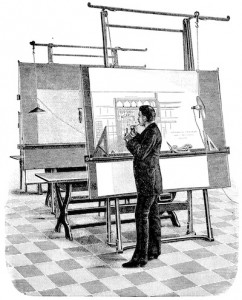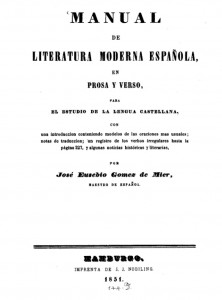I’ve written twice before about approaches to the survey course in medieval Iberian literature (or whatever you prefer to call it). The first time (Sep 2011), I took an ‘issues-based’ approach by which I applied a ‘big idea’ to whatever text I was teaching. I used mainly handouts of texts I had entered and glossed for my undergrad students, sometimes following the lead of popular anthologies and providing study questions, key concepts, a very minor apparatus. I was responding to student feedback (based on their written comments and their affect and my perceived level of their engagement during class) that suggested students will more readily engage a culturally unfamiliar text when it is paired with a cultural problem with which they are familiar. It’s a bit of conditioning: you pair a negative stimulus with an associated positive one, in order to transfer the positive attachment to the less attractive object. Your students might call it ‘relatability.’
This approach was a success in terms of leveraging interest in broader cultural problems (female beauty standard, sexual politics, ethical economies such as carbon credits, and so on). However, two problems persisted: I found it difficult to achieve a thematic or narrative cohesion for the course, something that the students pointed out in their written comments. Also, the teaching materials, a course reader made up of my own short pedagogical editions and photocopies of excerpts from modern editions, was hard to work with. It lacked consistent pagination, was not illustrated, and had no visual or thematic identity as a text.
In frustration, I reverted to the classic anthology (which I wrote about here in July 2013), a format with which I was familiar but with which I had serious reservations. I decided, for convenience’s sake, to go with the textbook. There were advantages: I used the reading comprehension questions for the daily online quizzes, and the thematic questions for exam questions. There was perfect clarity as to what was being assessed. I fielded very few procedural questions from students.
After teaching this format for a year, I was pleased with the clear-cut structure of the assessments, but still kept running up against the narrative problem. For students (and myself to a lesser degree), the History of Spanish Literature was not a meaningful rubric for organizing our readings. They are attracted to political and social narratives. More than anything else, they crave background information about the places and times in question. They find the original medieval Castilian difficult, disorienting, disheartening, but not distasteful.
In an attempt to address these concerns and to allow myself to return to teaching a more culturally inclusive vision of my understanding of the literary culture in the Peninsula during the first half of the second millennium, I decided to teach fewer works in their entirety, to give the students all texts in both Spanish and English (regardless of their original language of composition), and to assign trade books in English paired with each primary reading to give them abundant background information along with the narrative they seem to be craving. I was inspired by the example of my colleague Prof. S.J. Pearce (NYU), who has taught a similar course in English (focused on al-Andalus), and by a discussion I had with the Historian Prof. Brian Catlos (U Colorado) about organizing large survey courses. The result is the following course, organized thematically around questions of coexistence, conflict, and conquest. You can read a draft of the full syllabus here.
- María Rosa Menocal, Ornament of the World
- Cities of Light (Film)
- Richard Fletcher, Moorish Spain
- Clarke, The Muslim Conquest of Iberia: Medieval Arabic Narratives
- Poems of al-Mu’tamid (trans. Rubiera Mata)
- Jane Gerber, The Jews of Spain: A History of the Sephardic Experience
- Catlos, Infidel Kings and Unholy Warriors: Christians, Muslims and Jews in the Age of Crusade (chapters on Samuel Hanagid and Rodrigo Díaz de Vivar)
- Poems of Samuel Hanagid Nagrela (trans. Peter Cole; trans. Ángel Sáenz-Badillos)
- The Poem of the Cid (ed. Ian Michael, trans. Rita Hamilton and Janet Perry)
- Roger Wright, Spanish Ballads (especially romances fronterizos)
- Matthew Carr, Blood and Faith: The Purging of Muslim Spain
- Francisco Núñez Muley, Memorial (ed. Lingkua 2007; trans. Barletta;)
- Don Quijote (ed. Rico; trans. Grossman; chapters 1-3, and Ricote episdoe)
The idea with this approach is that the students come to the first day of class having read Menocal’s Ornament of the World and having viewed Cities of Light, and so have some historical and cultural background before getting down to the business of reading medieval texts. Each primary text is (ie paired with a historical study in English that gives them considerably more historical, political, and cultural background than the brief introductory paragraphs in a classic anthology, and the availability of English translations take the pressure off them to digest 13th- or 14th- century Castilian after just having come from third-year reading and composition courses.
In the fall, when I teach the survey course in a larger format (60-70 students, 2 lectures and one discussion section), it will include the New World. Our department has shifted to a survey system that covers the Hispanic-Latino world during a given time period, as opposed to teaching separate sequences in Peninsular and Latin American literature. I will probably add the Diario of Columbus and Naufragios by Cabeza de Vaca, either in a bilingual edition (Columbus) or separate Spanish and English editions (Cabeza de Vaca).
And by the way, I am still looking for an undergrad-friendly secondary source in English to provide historical and cultural background for the romances fronterizos. Any suggestions?




